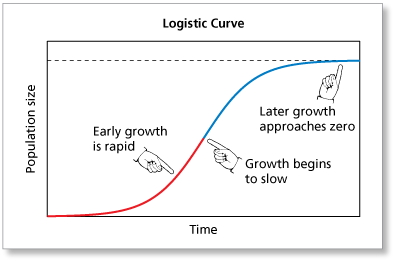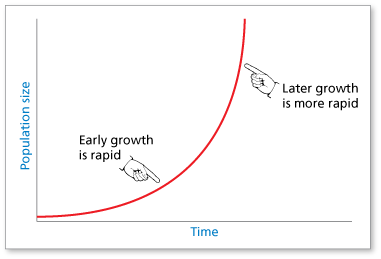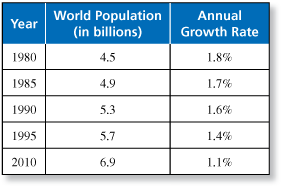-
In general, the size of a population (people, bacteria, cancer cells, etc.) follows a logistic growth pattern. The graph illustrates the growth patterns of a logistic curve. Compare an exponential curve to a logistic curve.

-
Logistic growth starts off like exponential growth. At a certain point, however, the rate of growth begins to decrease. Eventually the population has reached a maximum size and is barely growing.
Exponential growth does not taper off. It continues to grow more and more rapidly as time increases.

Comments (0)These comments are not screened before publication. Constructive debate about the information on this page is welcome, but personal attacks are not. Please do not post comments that are commercial in nature or that violate copyright. Comments that we regard as obscene, defamatory, or intended to incite violence will be removed. If you find a comment offensive, you may flag it.
When posting a comment, you agree to our Terms of Use.Showing 0 commentsSubscribe by email Subscribe by RSSThere are no comments. -
-
In general, the size of a population (people, bacteria, cancer cells, etc.) follows a logistic growth pattern. The graph illustrates the growth patterns of a logistic curve. Why is the size of a population over time better represented by a logistic growth model than an exponential growth model?

These comments are not screened before publication. Constructive debate about the information on this page is welcome, but personal attacks are not. Please do not post comments that are commercial in nature or that violate copyright. Comments that we regard as obscene, defamatory, or intended to incite violence will be removed. If you find a comment offensive, you may flag it.
When posting a comment, you agree to our Terms of Use. -
In general, the size of a population (people, bacteria, cancer cells, etc.) follows a logistic growth pattern. The graph illustrates the growth patterns of a logistic curve. Based on the information in the table, what part of the graph represents the world population? Explain.


-
The annual growth rate is decreasing. If this 30-year period is representative of the future growth of world population, then world population growth has moved into the blue part of the logistic curve.
These comments are not screened before publication. Constructive debate about the information on this page is welcome, but personal attacks are not. Please do not post comments that are commercial in nature or that violate copyright. Comments that we regard as obscene, defamatory, or intended to incite violence will be removed. If you find a comment offensive, you may flag it.
When posting a comment, you agree to our Terms of Use. -
-
To find the annual growth rate represented by Moore's Law, use the formula for exponential growth, A = P(1 + r)n . Because the number of transistors doubles every 2 years, you can substitute 2P for A and 2 for n in the formula. Then solve for r as shown. Suppose the number of transistors triples every two years. What is the annual growth rate?

These comments are not screened before publication. Constructive debate about the information on this page is welcome, but personal attacks are not. Please do not post comments that are commercial in nature or that violate copyright. Comments that we regard as obscene, defamatory, or intended to incite violence will be removed. If you find a comment offensive, you may flag it.
When posting a comment, you agree to our Terms of Use. -
What is the annual growth rate of tuition?

-
To estimate the annual rate of growth, you need to find a value of r such that

After some trial and error, you can see that the value of r is about 0.154. This means that the annual rate of growth was about 15.4%.
These comments are not screened before publication. Constructive debate about the information on this page is welcome, but personal attacks are not. Please do not post comments that are commercial in nature or that violate copyright. Comments that we regard as obscene, defamatory, or intended to incite violence will be removed. If you find a comment offensive, you may flag it.
When posting a comment, you agree to our Terms of Use. -
-
Using the rate from Exercise 25, what will tuition be in three more years?

These comments are not screened before publication. Constructive debate about the information on this page is welcome, but personal attacks are not. Please do not post comments that are commercial in nature or that violate copyright. Comments that we regard as obscene, defamatory, or intended to incite violence will be removed. If you find a comment offensive, you may flag it.
When posting a comment, you agree to our Terms of Use.





